Sweet, pungent, and intense, cloves are unforgettable.
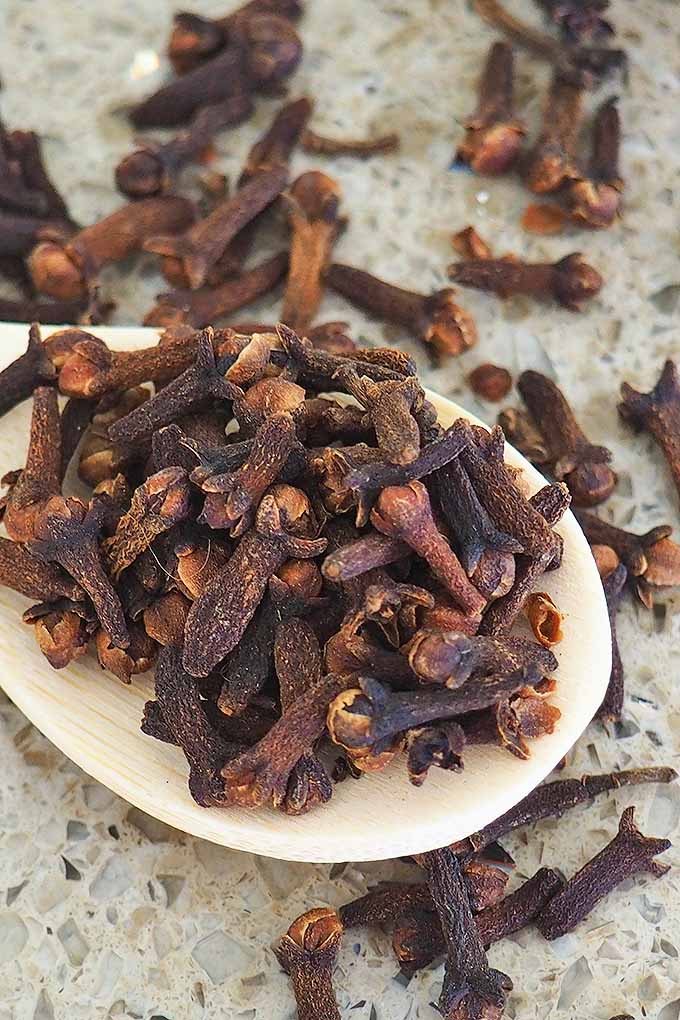
A mainstay in numerous cuisines, these aromatic dried flower buds are widely used in cooking, baking, spice blends, pickling blends, and condiments. They can also add unique flavor to a variety of beverages, from wine to tea.
This exotic spice is made from the dried buds of an evergreen tree in the Myrtaceae family, Syzygium aromaticumnative, native to the Maluku Islands in eastern Indonesia.
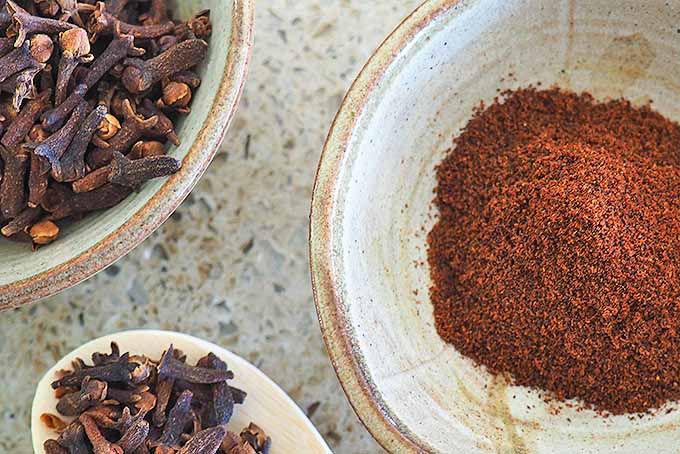
Wonderfully versatile, this deeply flavored spice is equally at home in a variety of both sweet and savory dishes.
Along with other spices such as cinnamon, ginger, peppercorns, and turmeric, cloves belong to a group of flavorings known as warming spices. That is, they have thermogenic properties that may help to raise core body temperatures and improve circulation, creating a warming effect.
In addition to their kitchen performance, cloves and other spices were often used as a food preservative that inhibits the growth of bacteria, and as a traditional curative. Currently, they’re still used in many medicinal applications for oral health, thanks to their powerful antiseptic, antimicrobial, and pain-relief properties.
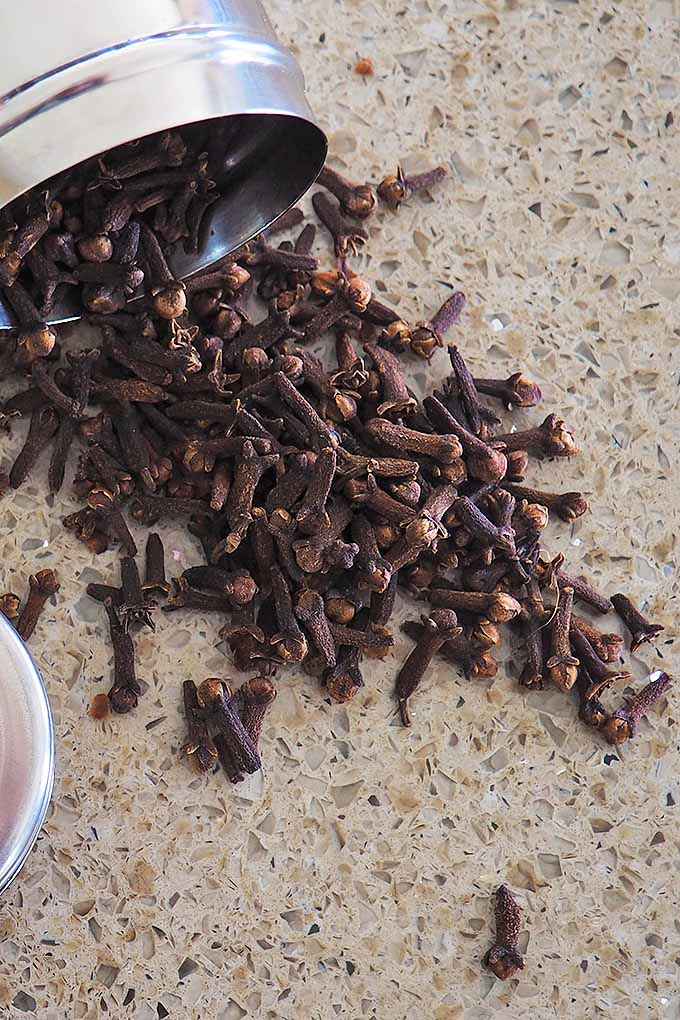
One of the crown jewels in the spice trade throughout Asia and the Middle East, by the late Middle Ages, only about 1 cup of the ground buds would cost a European master tradesman several days’ wages!
Join us for a closer look at this intriguing ingredient and how it became such a coveted commodity. We’ll also discuss its antioxidant properties and health benefits, how to use it in the kitchen, and proper storage and preparation methods.
From the Spice Islands
At one time, S. aromaticumnative grew exclusively on the Maluku Islands – often referred to as the Spice Islands because of the abundance of nutmeg, mace, and cloves that grew in this Indonesian archipelago.
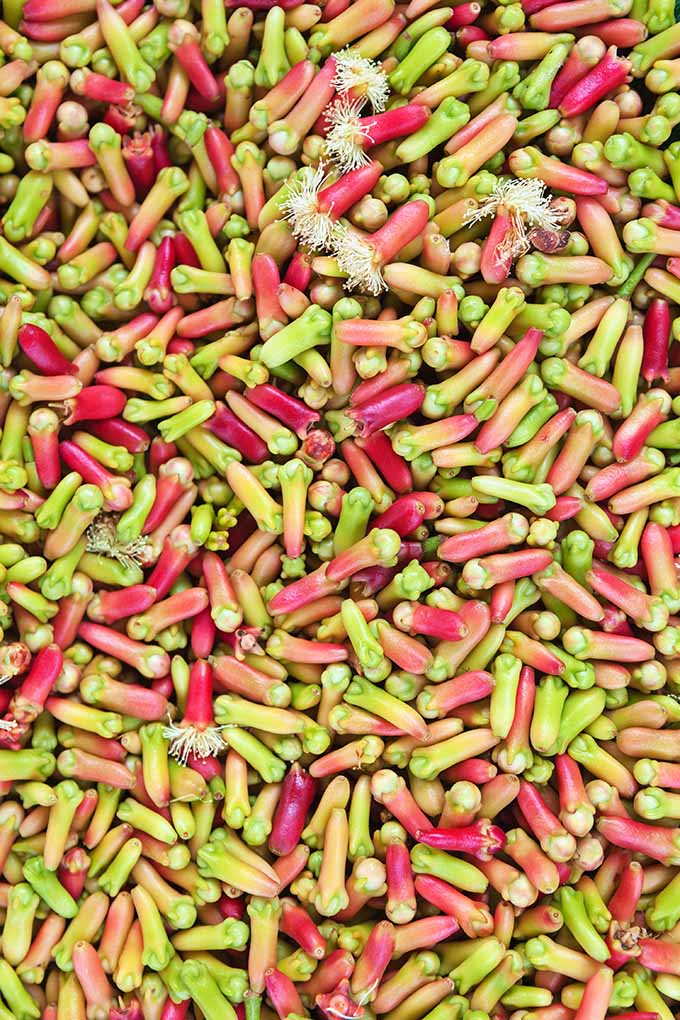
One of the most popular items in the modern spice rack, today these fragrant buds are harvested in Bangladesh, Indonesia, India, Madagascar, Pakistan, Sri Lanka, Tanzania, and Zanzibar.
The clove tree grows from about 25 to 50 feet in height, and has large, glossy ovate leaves. The clustered flower buds are harvested by hand just as they change color from green to pink. They are then spread on mats and dried in the sun for three days before being taken to collection centers.
They measure about 1/2 inch in length, with a tapered stem and rounded head that resembles small nails.
In fact, their old English name clufu is actually derived from the Latin word clavus, which means “little nail.”
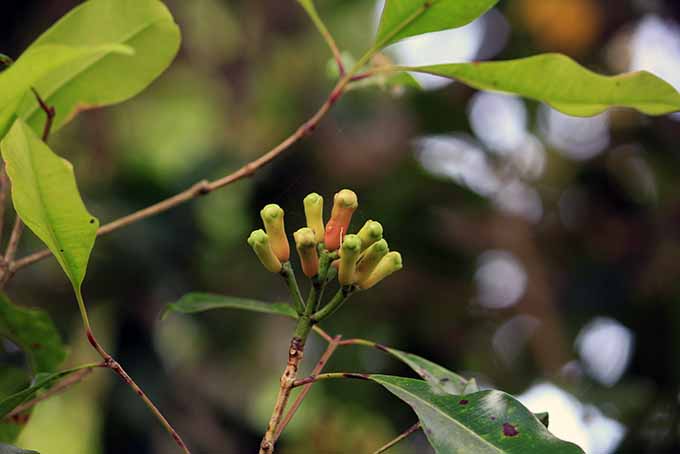
When dried, they have a hard exterior and are imbued with the flavor and fragrance of their primary compound, eugenol.
In Syria, traces of cloves have been found in ceramic cooking vessels dating to 1700 BC.
And in the tales of “The Arabian Nights”, we know that Sinbad the Sailor financed his remarkable voyages by trading in high-end commodities such as cloves, nutmeg, and cinnamon.

The Arabian Nights, available on Amazon
During the early Middle Ages, sailors and merchants from the Middle East and Asia traded the buds in the prosperous Indian Ocean spice routes. As European colonization expanded, these routes were taken over by the powers of the day, most notably the Venetians and Portuguese.
According to one source, shortly after its formation in 1600 in order to stabilize profits in the spice trade, the Dutch East India Company (DEIC) rapidly claimed control of trading rights in this area.
The DEIC created a tight monopoly for the rare flavorings of the day – nutmeg, mace, and cloves. Throughout the early 17th century, the DEIC continued to colonize Indonesia’s island’s, developing plantations for growing cloves and other spices for export.
Because of the growing demand for these rare spices, by the mid-1600s, prices had been squeezed until the value of some were equivalent to their weight in gold!
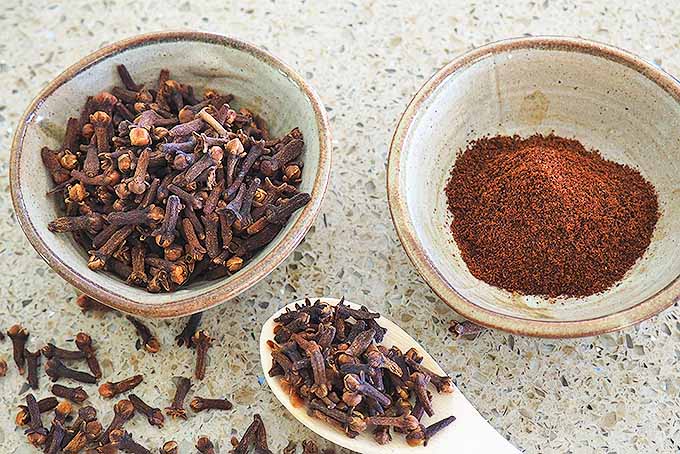
However, policing trees on the many Maluku Islands proved to be an impossible task, and by the 18th century, groves of pirated clove trees were being grown in areas ranging from Brazil to Zanzibar.
With open trade, prices came down, and eventually what was once a luxury item reserved for the wealthy became affordable for all households.
In the Kitchen
These buds are common ingredients in many global cuisines, particularly in regions of Africa and Asia.
They are also well-known for adding their warmly sweet and aromatic taste to autumn baking and cooking in North America, like our wonderful pumpkin spice scones, gingerbread, cookies, and pumpkin pie.
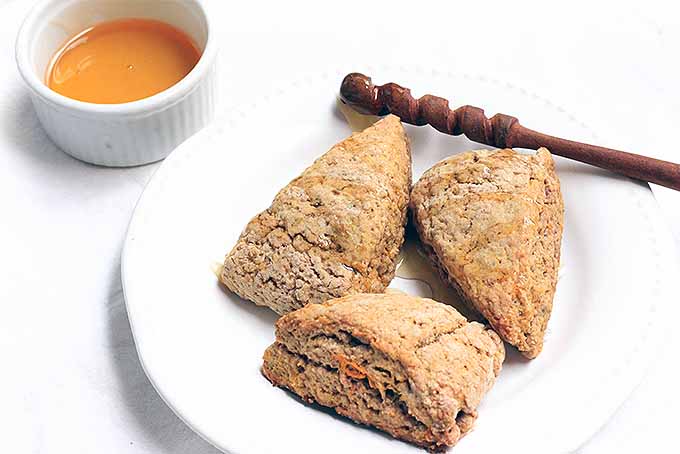
They add their distinct flavor to baked ham, roast pork, sauces, marinades, salad dressings. And they are featured in spice blends from around the world, like Moroccan ras el hanout, Indian garam masala, and the French quatre epices.
In Mexican cuisine, they’re often used in combination with cinnamon and cumin. And they can be added to a sachet of bouquet garni ingredients to flavor soups, stews, and casseroles.
Many types of chutney wouldn’t be chutney without cloves, and they’re equally delicious in relishes, pickles, and jams such as cherry or peach.
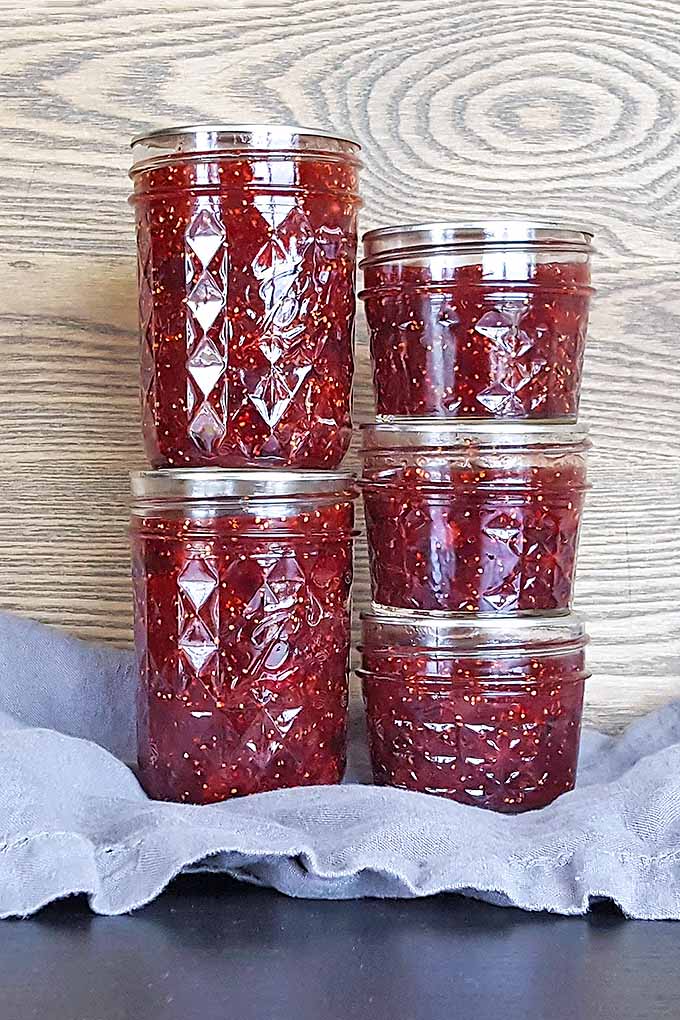
Or you can try this spiced fig and plum jam from our foodie friend Kristen at Feast in Thyme.
And if you ever grow too much zucchini and need a new recipe, they add a warm, wonderful taste to this zesty zucchini marmalade!
Their flavor really shines when married with fruits. Recipes for baked apples, canned peaches, poached pears, rhubarb crisp, or spiced plums with ice cream become simply scrumptious when these flavorful buds are added to a recipe.
They also add their deep, warm flavors to hot beverages like masala chai, cider, and mulled wine.
These aromatic buds also pair well with other spices and herbs, like allspice, basil, cinnamon, cumin, peppercorns, star anise, and vanilla. And it also makes a lovely companion with citrus peel, dark chocolate, onions, root vegetables, and winter squash.
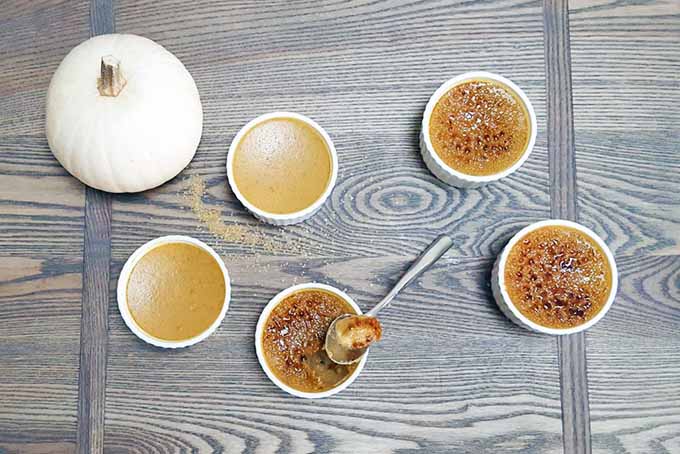
For a gorgeous combo of spices in a creamy dessert, try this maple bourbon pumpkin creme brulee, another delicious recipe from Feast in Thyme.
Because the eugenol imparts a strong, pungently intense flavor, only small amounts are required in most recipes.
When using whole buds to stud an ingredient, poke in the stem end so that just the bud heads are visible. And before serving, remove any whole buds – they’ll still have a strong, pungent taste.
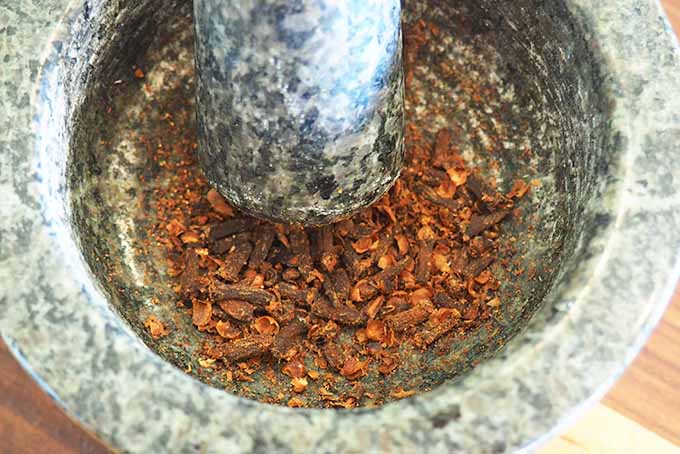
To enjoy the freshest flavor, use a mortar and pestle to grind just as much as is needed immediately prior to using.
And for more great ideas on cooking with aromatics, pick up a new edition of Ian Hemphill’s insightful book The Spice and Herb Bible.

The Spice and Herb Bible, available on Amazon.com
It’s a fascinating perspective from an insider’s point of view, and has several new recipes – many of which are delicious spice blends.
An Antioxidant Star
Cloves contain very high levels of the active component eugenol, which is commonly used in dentistry because of its antiseptic, anti-inflammatory, and pain-killing properties.
Eugenol is also found in high concentrations in basil, cinnamon, and nutmeg oils, and is a popular ingredient in products such as chewing gum, cough syrups, insect repellents, mouthwash, toothpaste, perfumes, soaps, and so on.
Based on the Phenol-Explorer Database of the 100 richest dietary sources of polyphenols, spices have the highest polyphenol content, followed by fruits, seeds, and vegetables. And among all of these ingredients, the buds of S. aromaticumnative rate the highest in both polyphenol content and antioxidant levels.
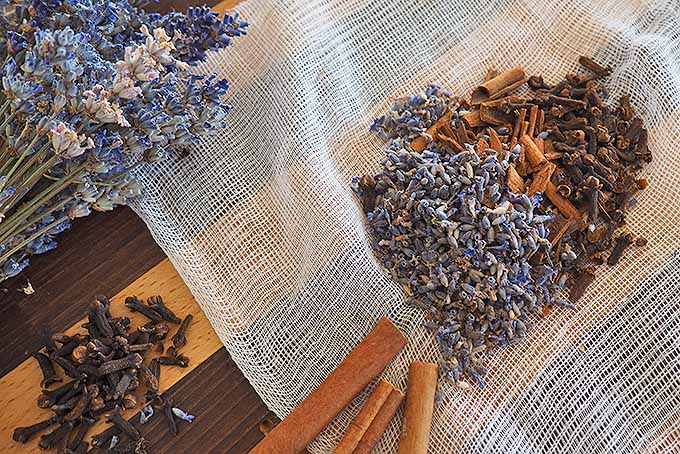
In addition to use in dentistry, they have many medicinal properties with a long history in Ayurvedic and Chinese medicinal practices, and Western herbalism.
The essential oil of cloves is used as a home remedy for toothache, to improve digestion, and when applied topically, for stimulation and warmth.
Studies into the efficacy of eugenol’s health benefits are ongoing. Thus far, the research is showing significant potential for health applications in several areas, such as improvement in diabetes symptoms, the reduction and prevention of chromic inflammation, as an inhibitor for oxidative stress, and as an aid in the maintenance of a healthy cardiovascular system.
Household Uses
With a heady scent reminiscent of carnations, these buds have a long history of use in perfumes and potpourri, and as a pleasant-smelling antiseptic.
For more on growing fragrant favorites like the carnation, see this post on out sister site, Gardener’s Path.
To freshen up closets, drawers, and enclosed areas with their spicy/sweet fragrance, make an all-natural sachet with cloves, either on their own or blended into a potpourri with other dried spices, herbs, or citrus.
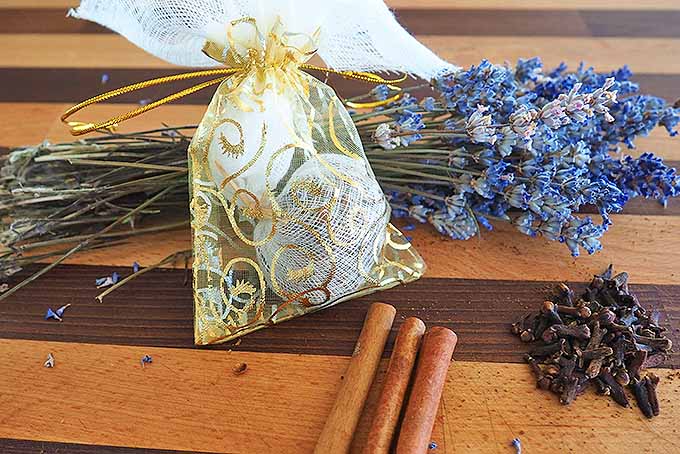
Here’s one of my favorite blends:
Into a mortar, add 2 tablespoons of whole cloves, 2 broken sticks of cinnamon, and 2 tablespoons of lavender. With a pestle, gently break the spices into large, coarse pieces, just enough to release their oils and fragrance. Then, place in the center of a square piece of cheesecloth.
Tie with a ribbon, and enjoy the intoxicating perfume that freshens up your space! Replenish your dried aromatics every month or so to maintain their fresh fragrance.
In winter, stud citrus fruits like oranges and lemons with whole buds to make a fragrant pomander that’s perfect as a gift. Scoop out the stem end and drop in a tealight, then let the warm scent of citrus and spices fill your room.
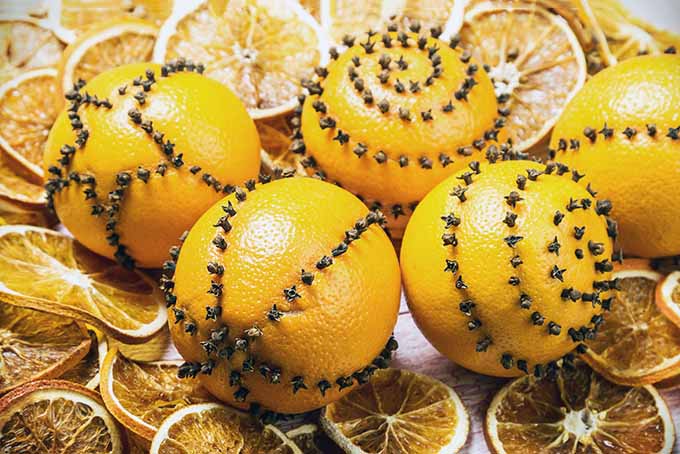
For a mold and mildew-busting solution, mix 1/4 teaspoon oil of cloves with about 4 cups of water in an empty spray bottle. Shake well and spray on affected areas and leave for several minutes to overnight if needed.
The eugenol oil kills the mold spores – which can then be scrubbed clean from surfaces with a stiff brush using a paste of baking soda and white vinegar. When clean, mist with the mixture again for its mold-prevention properties and pleasant aroma.
When buying the oil, ensure your purchase is undiluted, free of additives, and has a good-quality dropper for clean and accurate dispensing.
BioFinest Clove Leaf Oil, available on Amazon.com
Try this organic, 100% pure BioFinest Clove Leaf Oil, which also comes with a free e-book, “100 Ways to Use Essential Oil.”
Selection and Storage
When possible, buy whole cloves instead of ground, as ground spices can lose their flavor quickly.
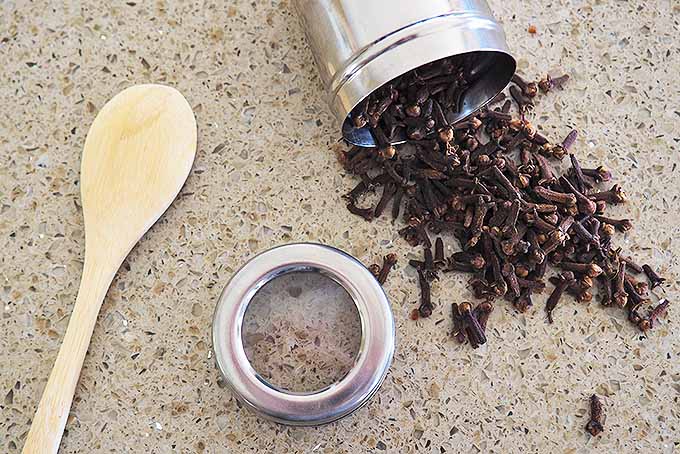
You should be able to find both whole and ground varieties in your local supermarket. Your local Asian market may have a good selection as well.
In both their whole and ground forms, dried spices are considered to be shelf stable. That is, they can be safely stored at room temperature without spoilage – which seems to give them an eternal shelf life.
That spice tin that’s been lurking in the cupboard corner for who knows how long may not appear to be spoiled, but it won’t have the full, robust flavor of whole or freshly ground spices.
While they won’t technically spoil, there is a limit to how long they’ll taste the freshest!
The shelf life of cloves and other spices, when stored properly, is 2 to 3 years in ground form, and 3 to 4 years in the whole form.
Like all spices (and loose leaf teas!), store them in a dark or opaque glass, ceramic, or stainless-steel jar with a tight-fitting lid, and stash in a cool, dry, and dark spot.
Heat from the stove and hood lights will hasten flavor and fragrance loss, so always pick a storage spot away from heat sources. That awkward little cupboard above the stove might seem like it’s the ideal spot for spices, but it gets too warm.
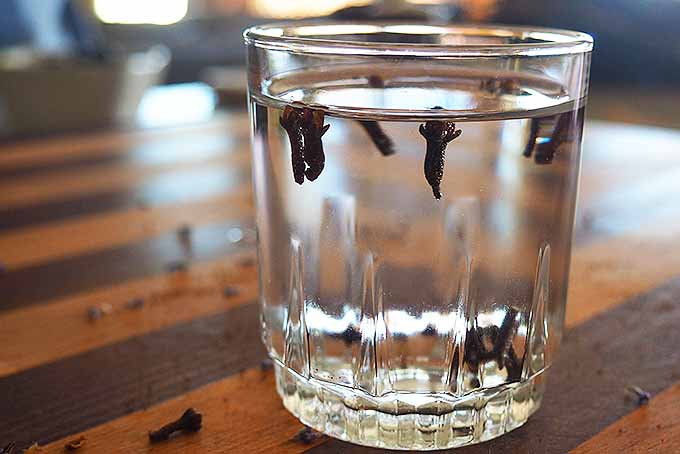
To test if whole cloves are still of good quality, place a few in a glass of water. If they float vertically, with their stems pointing down, they’re good to use. If they float horizontally or sink, they’ve passed their prime.
Maluku Magic
Cloves are one of the indispensable spices for the home cook.
They have outstanding antioxidant levels, as well as antiseptic and pain-relief properties. And the active ingredient eugenol looks to be another big player in the arena of promoting good health by busting chronic disease.
In the kitchen, the flavor and fragrance of these exotic buds from the Maluku Islands is incomparable!
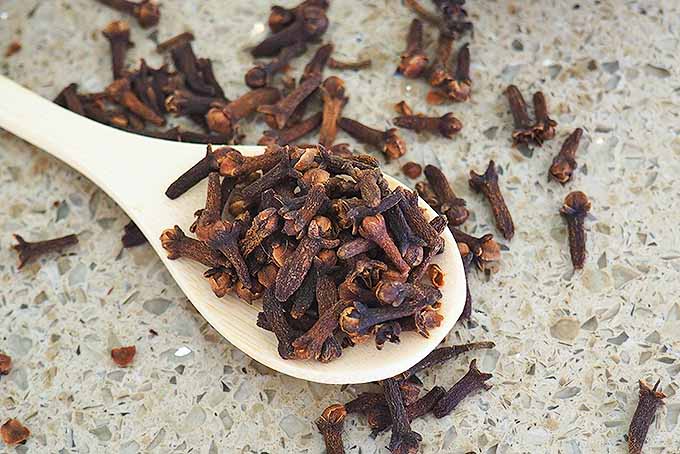
Whether in baked goods, with fruits, in stews or casseroles, spice blends, pickles, jams, or chutneys, their spicy sweet flavor adds a warm, comforting taste.
But remember, use sparingly and mind the recipe amounts – the flavor is intense, and it’s easy to overdo a good thing!
How about you readers? Any questions or comments on cloves you’d like to share? Drop us a note in the comments section below, or start a conversation on our Facebook page!
And don’t forget to dig into all of our spice and herb culinary guides and our check out our Ultimate Guide to Kitchen Herbs and Spices.
Don’t forget to Pin It!
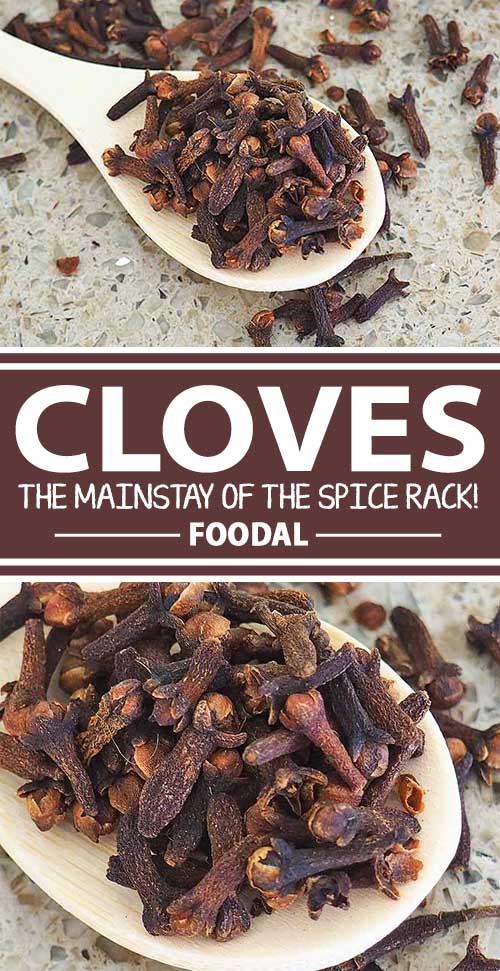
Photos by Lorna Kring and Felicia Lim, © Ask the Experts, LLC. ALL RIGHTS RESERVED. Other recipe photo credits: © Feast in Thyme. Used with permission. See our TOS for more details. Uncredited photos: Shutterstock.
The staff at Foodal are not medical professionals and this article should not be construed as medical advice. Foodal and Ask the Experts, LLC assume no liability for the use or misuse of the material presented above. Always consult with a medical professional before changing your diet, or using supplements or manufactured or natural medications.
About Lorna Kring
Recently retired as a costume specialist in the TV and film industry, Lorna now enjoys blogging on contemporary lifestyle themes. A bit daft about the garden, she’s particularly obsessed with organic tomatoes and herbs, and delights in breaking bread with family and friends.

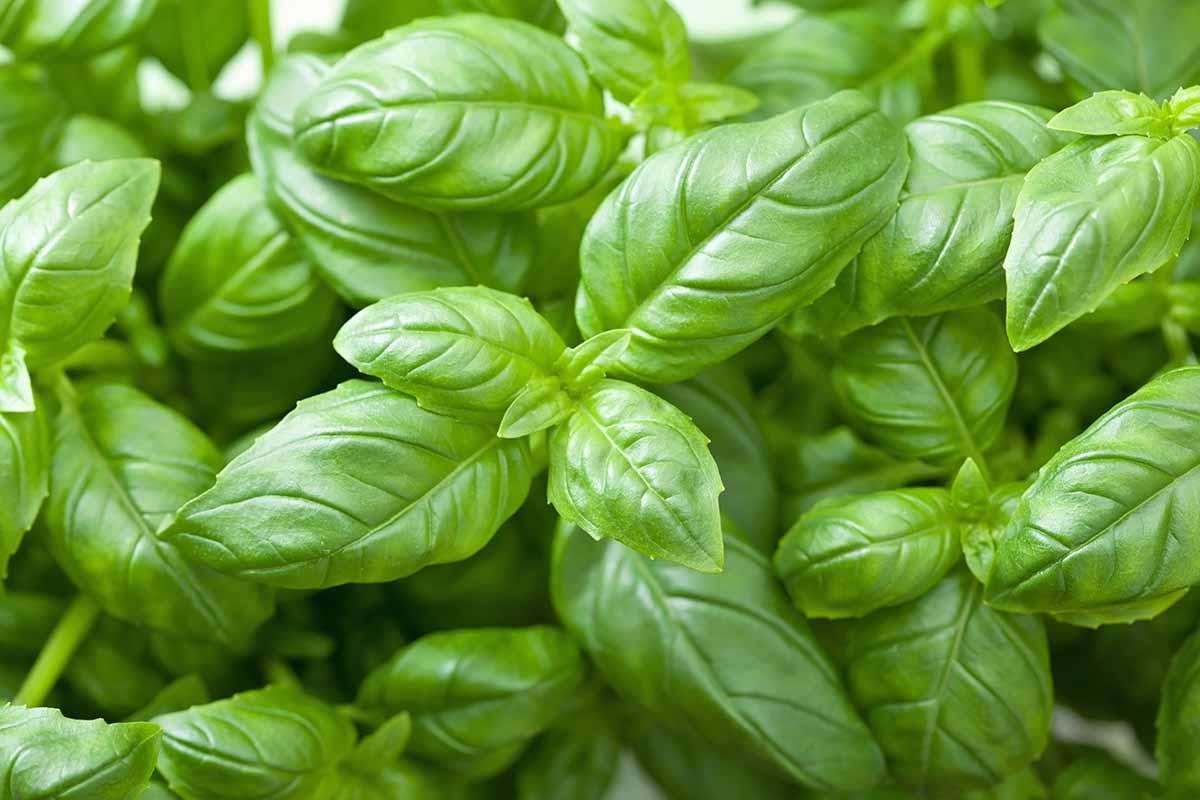
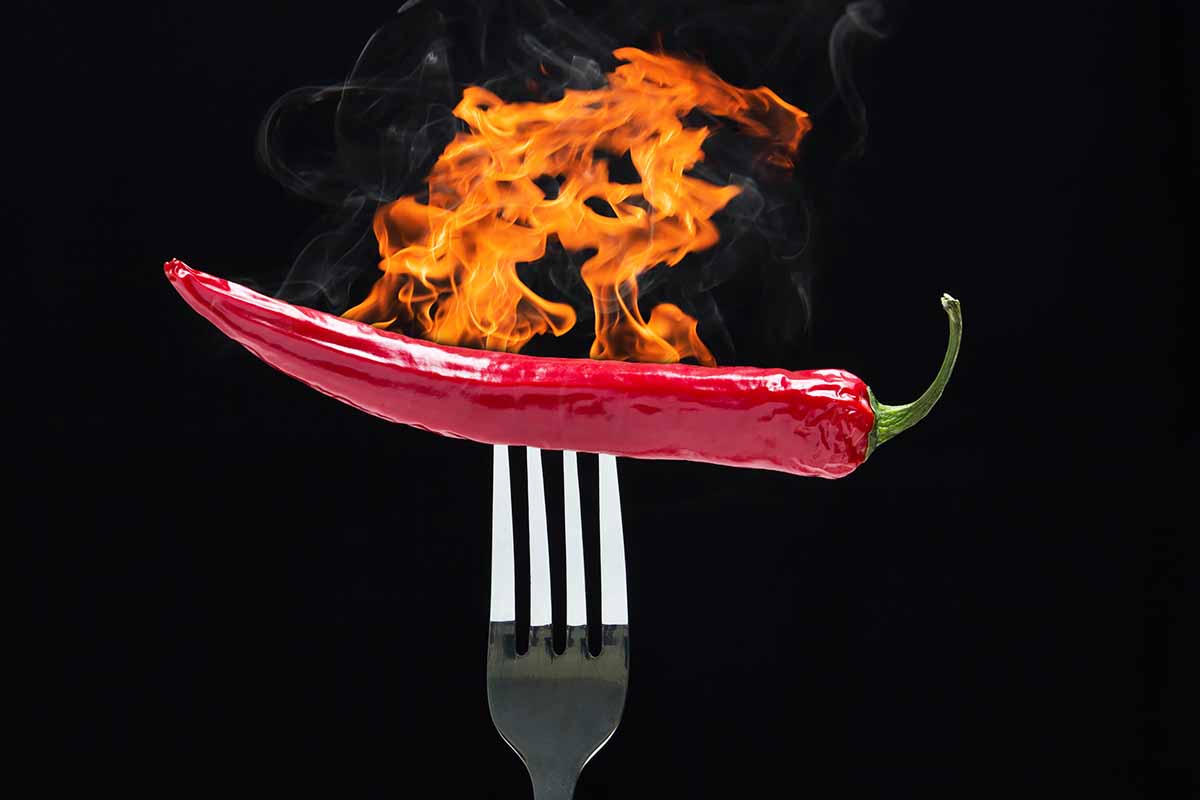
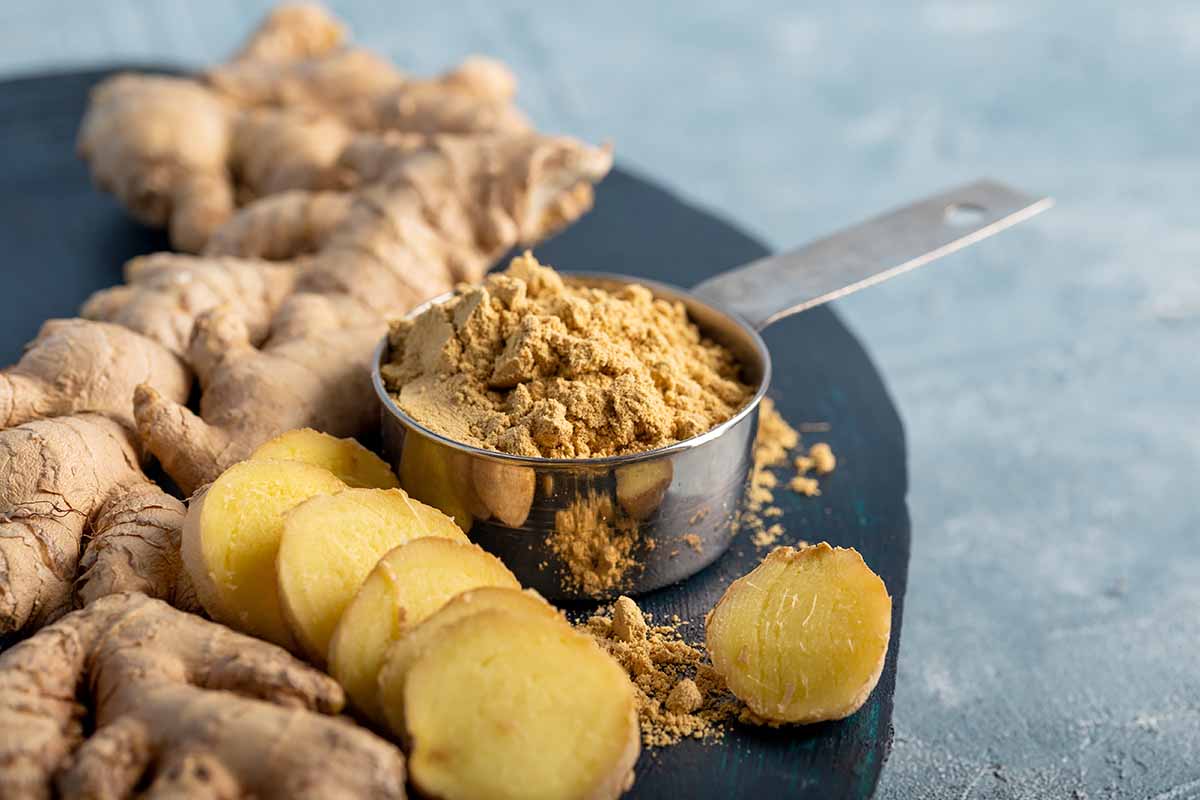
how much ground cloves will equal 6 whole cloves
Hi Davis,
Six whole cloves is equivalent to 1/2 teaspoon of the ground spice. But keep in mind that choosing this substitution all depends on what you’re cooking. The flavor achieved by adding the whole spice to a recipe and then removing it before serving will typically be more mild than what you’d get when adding the ground spice, unless perhaps the ground version has been on the shelf for awhile and lost some potency. On the other hand, if you’re going for a punch of flavor and a recipe calls for the ground version, grinding your own whole spice at home is your best bet.
Happy Cooking! 🙂
Thank you so much for writing this informative article. I use whole cloves to infuse water used for making Arabian coffee. I have this question: if I wanted to add it as a powder in the last two minutes of making a coffee, how much less should I use of a powder? By weight would be fine.
The ground version may infuse the water much more than the whole sticks. The whole sticks stay in the water for about 17 minutes; however, if I add ground cloves in the last two minutes, how much do you recommend I reduce the cloves?
I presently put 4 cloves (2 grams) in the water at start. How many grams should I add instead for the last two minutes of the boil of finely ground cloves?
Thank you.
Thanks for your question, Waleed. I’m more familiar with using cardamom to flavor this type of coffee, but the process would be similar- about 1 teaspoon of the ground spice is usually added to the water per 2 teaspoons of ground coffee beans. But I definitely agree with you- ground spices (as long as they are freshly ground, or pre-ground without being stored in your cabinet for too long, resulting in a loss of potency) will typically infuse the brew with a stronger flavor than whole spices, and this is probably too much to get the level of clove flavor that you are looking for.
The best method that I can recommend will involve a little experimentation- start with just 1/4 teaspoon, gauge the flavor, and increase as needed when you make your next batch, using a maximum of 1 teaspoon of ground cloves (about 2.1 grams). Good luck! Thanks for reading, and enjoy the brew!
Hi
I am nearing 70 years of age.
For improvement of general health:
Whole cloves –
1.how many cloves can I chew or drink in water, per day.
2.Is it better to drink it in the morning.
3.Hot or cold drink.
4.Can it be bad for me, if I use too many per day.
Thanks.
Johan
Hello, Johan!
Cloves in their whole format are not a dietary supplement that can be consumed “by the each.” They need to be treated like any other dried spice: due to their incredibly strong and concentrated flavor and aroma, they should be utilized in a ground format and consumed in very small quantities in tested recipes from expert sources. They are often blended with other spices in a variety of recipes.
We suggest that you research and use recipes in order to measure correct amounts. For example, ground cloves are featured in our recipe for Pumpkin Nut Muffins: https://foodal.com/recipes/muffins/pumpkin-nut/